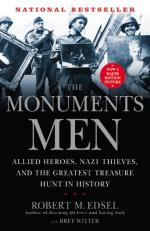
|
| Name: _________________________ | Period: ___________________ |
This test consists of 15 multiple choice questions and 5 short answer questions.
Multiple Choice Questions
1. Where was Ronald Balfour a historian prior to his service, according to the author in Part I: “The Mission,” Chapter 8?
(a) The University of Minnesota.
(b) Harvard University.
(c) King’s College, Cambridge.
(d) Yale University.
2. On what date was Michelangelo's Bruges Madonna sculpture taken by German soldiers in Belgium?
(a) June 6, 1944.
(b) July 17, 1944.
(c) March 6, 1944.
(d) September 7, 1944.
3. What field refers to the technical art of preserving older or damaged works of art?
(a) Reiteration.
(b) Alteration.
(c) Adulteration.
(d) Conservation.
4. According to the author, Givet, Belgium was a replacement depot when Harry Ettlinger arrived there. What term did the men call this staging area for replacement troops?
(a) A “timble bimble.”
(b) A “cross-depot.”
(c) A “repple depple.”
(d) A “lion’s gate.”
5. On what date did Harry Ettlinger ship out to basic training?
(a) December 7, 1941.
(b) April 16, 1943.
(c) August 27, 1942.
(d) August 11, 1944.
6. It was March of what year when the Germans annexed Austria?
(a) 1940.
(b) 1938.
(c) 1939.
(d) 1937.
7. Where was George Stout from?
(a) Cleveland, Mississippi.
(b) St. Louis, Missouri.
(c) Little Rock, Arkansas.
(d) Winterset, Iowa.
8. When did the defeat of the German-Italian forces at the Second Battle of El Alamein take place?
(a) November, 1944.
(b) October, 1944.
(c) October, 1942.
(d) January, 1943.
9. Who is cited with the quotation describing the scientific breakthroughs he made with George Stout between 1927 and 1932 in the introduction to Part I: “The Mission”?
(a) Johannes Vermeer.
(b) Lamont Moore.
(c) John Gettens.
(d) Sheldon Keck.
10. What archeological colleague of Colonel Wheeler’s “happened to be serving as an artillery captain in a unit near Leptis Magna,” according to the author in Part I: "The Mission," Chapter 5?
(a) Colonel George A. Taylor.
(b) Lieutenant Colonel John Bryan Ward-Perkins.
(c) Lieutenant George Stout.
(d) Second Lieutenant James J. Rorimer.
11. On what date did Japan bomb Pearl Harbor and catapult the U.S. into World War II?
(a) May 27, 1944.
(b) December 7, 1941.
(c) August 27, 1942.
(d) June 26, 1939.
12. What is the date of Rosenberg’s transmittal letter to Hitler accompanying albums of photographs of works of art stolen for the Führermuseum in Part I: “The Mission,” Chapter 7?
(a) July 17, 1944.
(b) April 16, 1943.
(c) August 27, 1942.
(d) March 18, 1945.
13. When did Captain Walker Hancock join George Stout on a mission to visit a repository that held Dutch masterpieces and an original Rembrandt and to arrange for the protection of the works?
(a) September 16, 1944.
(b) October 10, 1944.
(c) March 6, 1944.
(d) June 6, 1944.
14. In Part II: “Northern Europe,” Chapter 10, the author states that the naval bombardment of Omaha Beach began at 5:37 a.m. on what date?
(a) May 27, 1944.
(b) March 6, 1944.
(c) June 6, 1944.
(d) February 15, 1944.
15. Who rallied the survivors of the attack at Omaha Beach with the rallying cry, “Two kinds of people are staying on this beach, the dead and those who are going to die. Now let’s get the hell out of here,” according to the author in Part II: “Northern Europe,” Chapter 10?
(a) Private Harry Ettlinger.
(b) Captain Walter Huchthause.
(c) Colonel George A. Taylor.
(d) Major Ronald Edmund Balfour.
Short Answer Questions
1. When did the Battle of Aachen take place?
2. What does “MFAA” stand for?
3. What Austrian city did Hitler intend to redevelop into his own version of Florence, according to the author in Part I: “The Mission,” Chapter 2?
4. To whom is the letter addressed in Part II: “Northern Europe,” Chapter 17 from George Stout on October 4, 1944?
5. On what date did the Führer give the ERR the authorization to “search lodges, libraries and archives in the occupied territories of the west for material valuable to Germany, and to safeguard the latter through the Gestapo”?
|
This section contains 575 words (approx. 2 pages at 300 words per page) |

|




